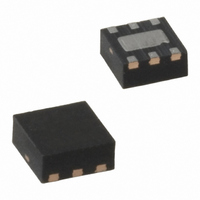MIC5259-2.5YML TR Micrel Inc, MIC5259-2.5YML TR Datasheet - Page 8

MIC5259-2.5YML TR
Manufacturer Part Number
MIC5259-2.5YML TR
Description
IC,VOLT REGULATOR,FIXED,+2.5V,CMOS,LLCC,6PIN,PLASTIC
Manufacturer
Micrel Inc
Datasheet
1.MIC5259-2.5YD5_TR.pdf
(11 pages)
Specifications of MIC5259-2.5YML TR
Regulator Topology
Positive Fixed
Voltage - Output
2.5V
Voltage - Input
Up to 6V
Voltage - Dropout (typical)
0.3V @ 300mA
Number Of Regulators
1
Current - Output
300mA
Current - Limit (min)
350mA
Operating Temperature
-40°C ~ 125°C
Mounting Type
Surface Mount
Package / Case
6-MLF®, QFN
Lead Free Status / RoHS Status
Lead free / RoHS Compliant
Other names
576-2831-2
MIC5259-2.5YML TR
MIC5259-2.5YMLTR
MIC5259-2.5YMLTR
MIC5259-2.5YML TR
MIC5259-2.5YMLTR
MIC5259-2.5YMLTR
Application Information
Enable/Shutdown
The MIC5259 comes with an active-high enable pin that
allows the regulator to be disabled. Forcing the enable
pin low disables the regulator and sends it into a “zero”
off-mode-current state. In this state, current consumed
by the regulator goes nearly to zero. Forcing the enable
pin high enables the output voltage. This part is CMOS
and the enable pin cannot be left floating; a floating
enable pin may cause an indeterminate state on the
output.
Input Capacitor
The MIC5259 is a high performance, high bandwidth
device. Therefore, it requires a well-bypassed input
supply for optimal performance. A 1µF capacitor is
required from the input-to-ground to provide stability.
Low-ESR ceramic capacitors provide optimal perform-
ance at a minimum of space. Additional high frequency
capacitors, such as small valued NPO dielectric type
capacitors, help filter out high frequency noise and are
good practice in any RF based circuit.
Output Capacitor
The MIC5259 requires an output capacitor for stability.
The design requires 1µF or greater on the output to
maintain stability. The design is optimized for use with
low-ESR ceramic chip capacitors. High ESR capacitors
may cause high frequency oscillation. The maximum
recommended ESR is 300mΩ. The output capacitor can
be increased, but performance has been optimized for a
1µF ceramic output capacitor and does not improve
significantly with larger capacitance.
X7R/X5R
recommended because of their temperature perform-
ance. X7R-type capacitors change capacitance by 15%
over their operating temperature range and are the most
stable type of ceramic capacitors. Z5U and Y5V
dielectric capacitors change value by as much as 50%
and 60%, respectively, over their operating temperature
ranges. To use a ceramic chip capacitor with Y5V
dielectric, the value must be much higher than an X7R
ceramic capacitor to ensure the same minimum
capacitance over the equivalent operating temperature
range.
Micrel, Inc.
September 2006
dielectric-type
ceramic
capacitors
are
8
Bypass Capacitor
A capacitor is required from the noise bypass pin to
ground to reduce output voltage noise. The capacitor
bypasses the internal reference. A 0.01µF capacitor is
recommended for applications that require low-noise
outputs. The bypass capacitor can be increased, further
reducing noise and improving PSRR. Turn-on time
increases slightly with respect to bypass capacitance. A
unique quick-start circuit allows the MIC5259 to drive a
large capacitor on the bypass pin without significantly
slowing turn-on time. Refer to the “Typical Character-
istics” section for performance with different bypass
capacitors.
Active Shutdown
The MIC5259 also features an active shutdown clamp,
which is an N-Channel MOSFET that turns on when the
device is disabled. This allows the output capacitor and
load to discharge, de-energizing the load.
No-Load Stability
The MIC5259 will remain stable and in regulation with no
load unlike many other voltage regulators. This is
especially important in CMOS RAM keep-alive applica-
tions.
Thermal Considerations
The MIC5259 is designed to provide 300mA of
continuous current in a very small package. Maximum
power dissipation can be calculated based on the output
current and the voltage drop across the part. To
determine the maximum power dissipation of the
package, use the junction-to-ambient thermal resistance
of the device and the following basic equation:
TJ(max) is the maximum junction temperature of the die,
125°C, and TA is the ambient operating temperature.
θJA is layout dependent; Table 1 shows examples of
junction-to-ambient thermal resistance for the MIC5259.
(M5 or D5)
SOT-23-5
MLF (ML)
Package
P
D(max)
Minimum Footprint
θ
Table 1. Thermal Resistance
JA
=
Recommended
⎛
⎜
⎜
⎝
235°C/W
90°C/W
T
J(max)
θ
JA
−
T
A
⎞
⎟
⎟
⎠
θ
Copper Clad
JA
185°C/W
1” Square
M9999-091406
MIC5259
145°C/W
θ
JC












